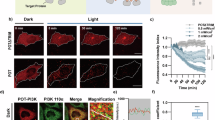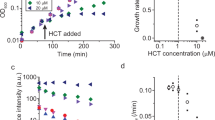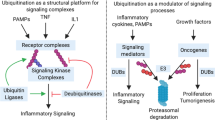Abstract
We searched for compounds that affect the cyclin D1/retinoblastoma protein pathway from the in-house natural product library using a recombinant adenovirus with the Cre/loxP-regulated cyclin D1 overexpression system, and we found that oligomycin inhibited cell growth more effectively in cyclin D1-overexpressing SW480 cells than in control SW480 cells. We also found that oligomycin reduced the expression levels of cyclin D1 protein and that this reduction is, at least in part, mediated by Thr-286 phosphorylation-dependent proteasomal degradation.
Similar content being viewed by others
Log in or create a free account to read this content
Gain free access to this article, as well as selected content from this journal and more on nature.com
or
References
Draetta, G. F. Mammalian G1 cyclins. Curr. Opin. Cell Biol. 6, 842–846 (1994).
Hunter, T. & Pines, J. Cyclins and cancer. II: cyclin D and CDK inhibitors come of age. Cell 79, 573–582 (1994).
Sherr, C. J. G1 phase progression: cycling on cue. Cell 79, 551–555 (1994).
Nevins, J. R. The Rb/E2F pathway and cancer. Hum. Mol. Genet. 10, 699–703 (2001).
Saito, M. et al. Amplification of the E2F1 transcription factor gene in the HEL erythroleukemia cell line. Genomics 25, 130–138 (1995).
Endo, N. et al. Herbimycin A induces G1 arrest through accumulation of p27(Kip1) in cyclin D1-overexpressing fibroblasts. Biochem. Biophys. Res. Commun. 267, 54–58 (2000).
Pirkmaier, A., Yuen, K., Hendley, J., O'Connell, M. J. & Germain, D. Cyclin d1 overexpression sensitizes breast cancer cells to fenretinide. Clin. Cancer Res. 9, 1877–1884 (2003).
Dong, Y. B., Yang, H. L., Elliott, M. J. & McMasters, K. M. Adenovirus-mediated E2F-1 gene transfer sensitizes melanoma cells to apoptosis induced by topoisomerase II inhibitors. Cancer Res. 62, 1776–1783 (2002).
Imoto, M. et al. Isolation and structure determination of inostamycin, a novel inhibitor of phosphatidylinositol turnover. J. Nat. Prod. 53, 825–829 (1990).
Sweet, S. & Singh, G. Accumulation of human promyelocytic leukemic (HL-60) cells at two energetic cell cycle checkpoints. Cancer Res. 55, 5164–5167 (1995).
Gemin, A., Sweet, S., Preston, T. J. & Singh, G. Regulation of the cell cycle in response to inhibition of mitochondrial generated energy. Biochem. Biophys. Res. Commun. 332, 1122–1132 (2005).
Diehl, J. A., Cheng, M., Roussel, M. F. & Sherr, C. J. Glycogen synthase kinase-3beta regulates cyclin D1 proteolysis and subcellular localization. Genes Dev. 12, 3499–3511 (1998).
Kwak, Y. T. et al. IkappaB kinase alpha regulates subcellular distribution and turnover of cyclin D1 by phosphorylation. J. Biol. Chem. 280, 33945–33952 (2005).
Casanovas, O. et al. Osmotic stress regulates the stability of cyclin D1 in a p38SAPK2-dependent manner. J. Biol. Chem. 275, 35091–35097 (2000).
Okabe, H. et al. A critical role for FBXW8 and MAPK in cyclin D1 degradation and cancer cell proliferation. PLoS ONE 1, e128 (2006).
Agami, R. & Bernards, R. Distinct initiation and maintenance mechanisms cooperate to induce G1 cell cycle arrest in response to DNA damage. Cell 102, 55–66 (2000).
Kim, J. W., Adachi, H., Shin-ya, K., Hayakawa, Y. & Seto, H. Apoptolidin, a new apoptosis inducer in transformed cells from Nocardiopsis sp. J. Antibiot. (Tokyo) 50, 628–630 (1997).
Moran, E. Interaction of adenoviral proteins with pRB and p53. FASEB J. 7, 880–885 (1993).
Acknowledgements
This study was supported in part by the Global COE program for Human Metabolomic Systems Biology from MEXT, Japan.
Author information
Authors and Affiliations
Corresponding author
Rights and permissions
About this article
Cite this article
Kanai, M., Iba, S., Okada, R. et al. Oligomycin induced the proteasomal degradation of cyclin D1 protein. J Antibiot 62, 425–429 (2009). https://doi.org/10.1038/ja.2009.47
Received:
Revised:
Accepted:
Published:
Issue date:
DOI: https://doi.org/10.1038/ja.2009.47



